Imperial Red Granite originates from the Ilkal region in Karnataka’s Bagalkot district and from quarries in Madhya Pradesh, India. This natural stone forms through slow cooling of molten magma deep within Earth’s crust, creating a dense, durable igneous rock composed primarily of feldspar (responsible for the red coloration), quartz, and mica minerals. The combination produces a uniquely vibrant and hard-wearing material ideal for heavy-use areas.
The stone’s deep red background with contrasting black, white, and grey mineral specks creates visual warmth and elegance suitable for both traditional and contemporary design styles. Architects and homeowners specify this material for kitchen countertops where heat and scratch resistance are priorities, bathroom vanity tops requiring stain resistance, commercial lobby flooring subject to high traffic, exterior building cladding, landscape paving features, fireplace surrounds, and monumental applications including headstones.
The color intensity and pattern vary slightly depending on quarry location and extraction depth. Light pink to dark red shades exist within the Imperial Red designation, with lighting conditions and finishing techniques affecting final appearance. For large commercial projects requiring color consistency, buyers should request sample approval from the same quarry face to ensure matching blocks.
Performance and Quality
Imperial Red Granite demonstrates exceptional performance characteristics verified through ASTM testing protocols. Water absorption of 0.09% significantly exceeds the granite industry standard of 0.40% maximum, indicating extremely low porosity that resists staining agents and moisture penetration. This characteristic provides superior performance in kitchen and bathroom applications where spills are common.
The compressive strength of 186.27 N/mm² exceeds minimum requirements for structural applications, supporting its use in load-bearing installations including countertops, flooring, and cladding systems. Flexural strength of 13.83 N/mm² allows the material to resist bending forces in cantilever and spanning configurations without failure.
Heat resistance extends to temperatures around 250°C (480°F), making it unlikely to crack with normal exposure from cookware, fireplaces, or outdoor temperature fluctuations. However, extreme and rapid temperature changes can potentially cause thermal stress cracking. Users should employ trivets or hot pads for cookware placed directly from stovetops or ovens to prevent localized thermal gradients that might initiate cracking.
The stone’s hardness surpasses most kitchen utensils, providing excellent scratch resistance for food preparation surfaces. While not completely scratch-proof, normal use of knives and cooking implements will not damage the polished finish. The material resists bacteria retention better than many synthetic countertop surfaces, contributing to hygienic food preparation environments.
Materials and Construction
As an igneous rock, Imperial Red forms from molten magma that cools slowly at significant depth beneath Earth’s surface. This cooling process creates interlocking mineral crystals visible to the naked eye—a granular and phaneritic texture characteristic of granite. The red coloration derives primarily from potassium feldspar content, while black specks indicate biotite mica and hornblende minerals, and lighter areas represent quartz and plagioclase feldspar.
The coarse to very coarse grain structure contributes to the stone’s durability and polishing characteristics. During fabrication, manufacturers may apply clear epoxy resin to micro-fissures or minor surface pitting during polishing. This treatment provides a smoother finished surface without compromising structural integrity or affecting performance under normal use conditions.
Parameter |
Description |
| Slab Sizes | Gang Saw Slabs: 280 x 180 CM up in 2, 3 CM, and other Cutter Slabs: 180 x 60 CM up in 2, 3 CM, and other |
| Tiles | 30×30, 30×60, 40×40, 60×40, 60×60, 60 x 90, 60×120 CM in various thicknesses and custom sizes |
| Thickness | 6 mm, 18 mm, 20 mm, 30 mm & custom options |
| Others | Window sills, thresholds, monuments, steps & treads, flagstones, & articles available in custom sizes |
| Finishes | Polished, honed, leathered, bush hammered, lepatora, flamed, shotblasted |
| Standard Thickness | 18 MM (other thicknesses available) |
| Place of Origin | South India |
Maintenance and Care
Imperial Red Granite requires minimal maintenance compared to other natural stones, making it suitable for busy residential and commercial environments. Daily cleaning requires only mild soap and warm water solution applied with soft cloth or microfiber mop. Avoid harsh chemicals, acidic cleaners (vinegar, citrus-based products), or abrasive scrubbers that can etch or dull the polished finish over time.
Address spills promptly, particularly from wine, coffee, oils, and acidic beverages. While the low absorption rate provides good stain resistance, proper sealing enhances protection. Test sealing requirements on a small sample section—some Imperial Red blocks are dense enough that excessive sealing attempts may create residue buildup rather than penetration.
When sealing is appropriate, apply quality impregnating (penetrating) sealer annually to enhance durability and stain resistance. For countertops, establish routine of wiping surfaces after food preparation and using cutting boards to minimize surface contact with acidic foods. For flooring installations, daily dust mopping and weekly damp mopping with neutral cleaner maintain appearance. Professional deep cleaning annually extends longevity.
Expected service life for interior countertops ranges from 25 to 50+ years with proper maintenance. Flooring and exterior cladding typically provide 50 to 100+ years of functional performance based on documented granite longevity in infrastructure applications.
Installation and Compatibility
Professional installation by experienced stone fabricators ensures optimal results and warranty coverage. Imperial Red’s density and hardness necessitate specialized equipment including diamond-blade wet saws for cutting, CNC routing machines for sink cutouts and edge profiles, and vacuum suction systems for safe slab handling. The material requires carbide-tipped or diamond tooling for all cutting, drilling, and edge-finishing operations.
For countertop installations, fabricators create template measurements, cut slabs to specification, polish edges to desired profile, and install using appropriate adhesives. Typical installation takes 1-3 days for standard kitchen configurations. For flooring, use modified thin-set mortar specifically rated for natural stone over properly prepared substrate. Grout color selection affects final appearance—charcoal or grey tones harmonize with the stone’s natural palette.
Exterior cladding systems should incorporate mechanical anchoring per ASTM C1242 guidelines rather than adhesive-only methods, particularly in seismic zones or freeze-thaw climates where structural movement or thermal cycling occurs. Consult structural engineers for specific anchoring load calculations on facades exceeding 15 meters in height.
PROS & CONS
Advantages
- Exceptional durability: Low water absorption (0.09%) and high compressive strength (186.27 N/mm²) exceed standard granite performance
- Heat and scratch resistance: Withstands temperatures to 250°C and resists scratching from kitchen utensils and normal use
- Low maintenance requirements: Simple daily cleaning with mild soap; annual sealing maintains optimal stain resistance
- Distinctive aesthetics: Rare deep red coloration with mineral specks creates visual warmth unsuitable for common granite varieties
Considerations
- Premium pricing: Rare red pigmentation and limited quarry locations command higher cost than grey or beige granites
- Color variation exists: Shades range from light pink to dark red depending on quarry location and block depth; sample approval recommended
- Professional installation required: Dense, hard material demands specialized diamond tooling and experienced fabricators; not suitable for DIY
WHO SHOULD BUY
Ideal Buyers
- Residential renovators seeking distinctive, premium countertop material with proven heat and scratch resistance for kitchen projects
- Commercial developers requiring durable, low-maintenance flooring for hospitality lobbies, office reception areas, and retail spaces
- Monument fabricators needing long-lasting stone with symbolic red coloration for memorials and commemorative installations
- Architects specifying natural stone for exterior cladding projects where rare coloration creates architectural distinction
- High-end hospitality projects seeking luxury aesthetic with practical durability for bars, concession stands, and custom furniture
Not Recommended For
- Budget-conscious projects where cost is primary concern over aesthetics (consider more common grey or beige granites)
- Ultra-minimalist Scandinavian or industrial design schemes preferring neutral grey, white, or black palettes
- Large installations requiring perfectly uniform color with no variation (consider engineered quartz instead)
- DIY installers without access to diamond tooling and professional stone fabrication equipment
- Projects requiring immediate material availability without advance planning for procurement lead times
FAQs
Q1: What causes the red color in Imperial Red Granite, and does it fade over time?
The red coloration results from iron-rich potassium feldspar (orthoclase) formed during magma crystallization. This natural pigmentation is permanent and will not fade with normal indoor use or outdoor sun exposure. UV-stable mineral composition maintains color integrity for 50+ years.
Q2: Can I place hot pans directly from the stove onto Imperial Red Granite countertops?
While Imperial Red resists heat to approximately 250°C (480°F), placing hot pans directly on the surface is not recommended. Rapid localized temperature changes can potentially cause thermal stress cracking. Always use trivets or hot pads to protect the surface and prevent damage.
Q3: How does Imperial Red compare to New Imperial Red Granite—are they the same stone?
Imperial Red and New Imperial Red are closely related varieties from the same Karnataka and Madhya Pradesh quarrying regions, but they represent different blocks with slight color and pattern variations. New Imperial Red typically exhibits slightly darker, more uniform red tones. Both meet the same ASTM standards and performance specifications.
Q4: Is Imperial Red Granite suitable for outdoor kitchen countertops in cold climates?
Yes. The extremely low water absorption (0.09%) and high compressive strength make it suitable for outdoor applications including freeze-thaw climates. Proper sealing with quality penetrating sealer and routine maintenance ensure long-term performance. The material has documented frost resistance based on ASTM testing.
Q5: How often should Imperial Red Granite be sealed, and what type of sealer should I use?
Apply impregnating (penetrating) sealer annually to enhance stain resistance. Test a small sample section first—some Imperial Red blocks are dense enough that excessive sealing may create surface residue. If water beads on the surface for 5+ minutes without soaking in, sealing frequency can be reduced to every 2-3 years.
Q6: What is the typical lifespan for Imperial Red Granite in high-traffic commercial flooring?
With proper installation and maintenance, expect 50-100+ years of functional performance in commercial flooring applications. The high compressive strength (186.27 N/mm²) and abrasion resistance support heavy foot traffic. Re-polishing every 20-30 years can restore surface luster if wear patterns develop in extreme-traffic areas.

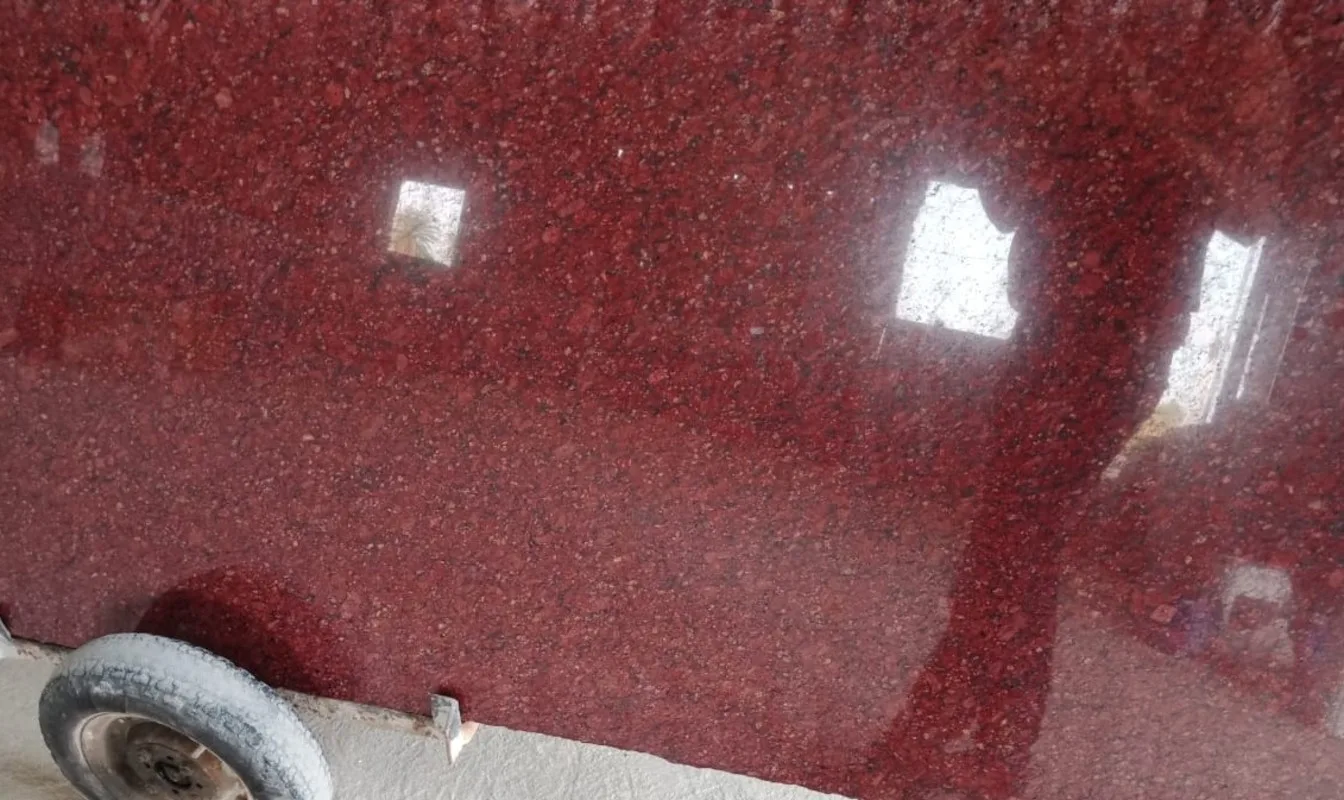
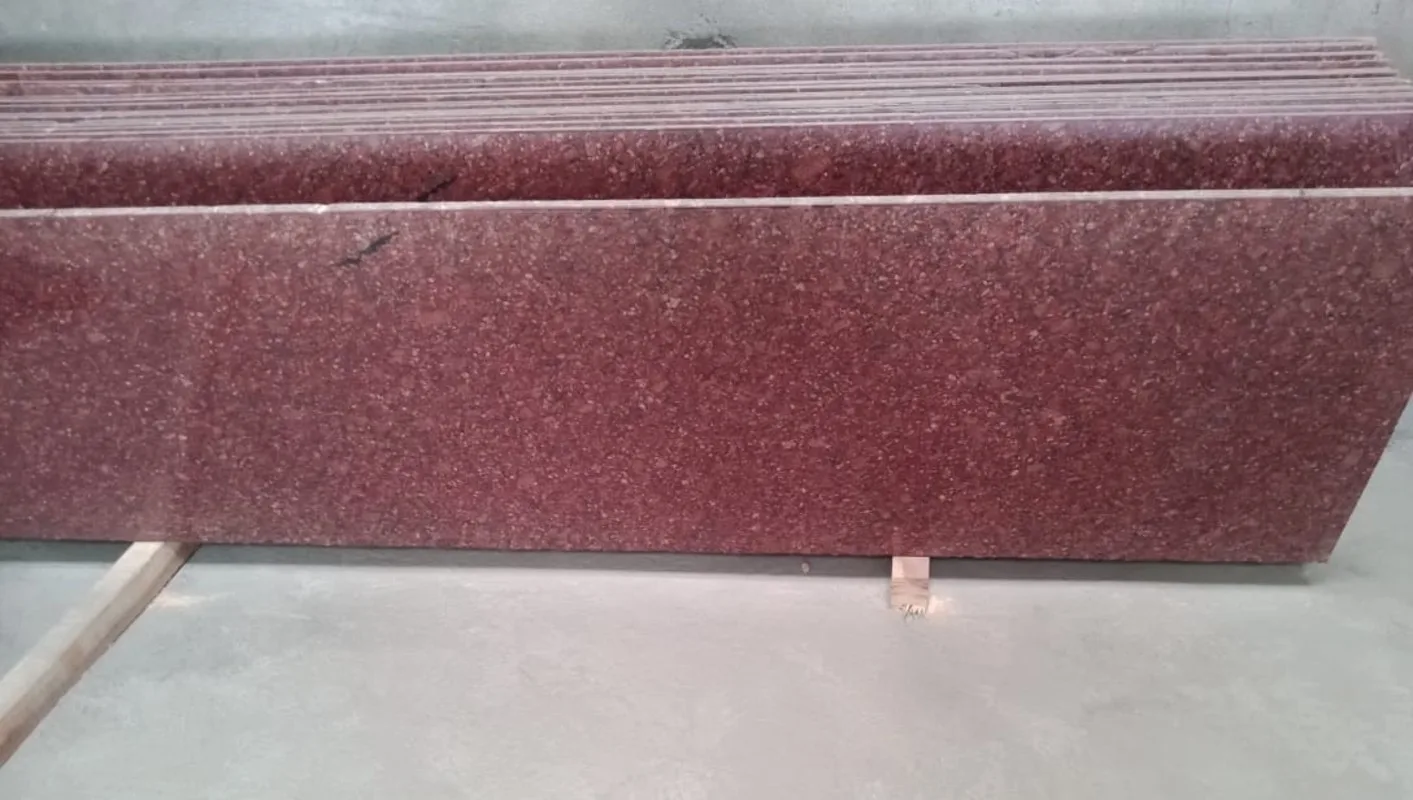
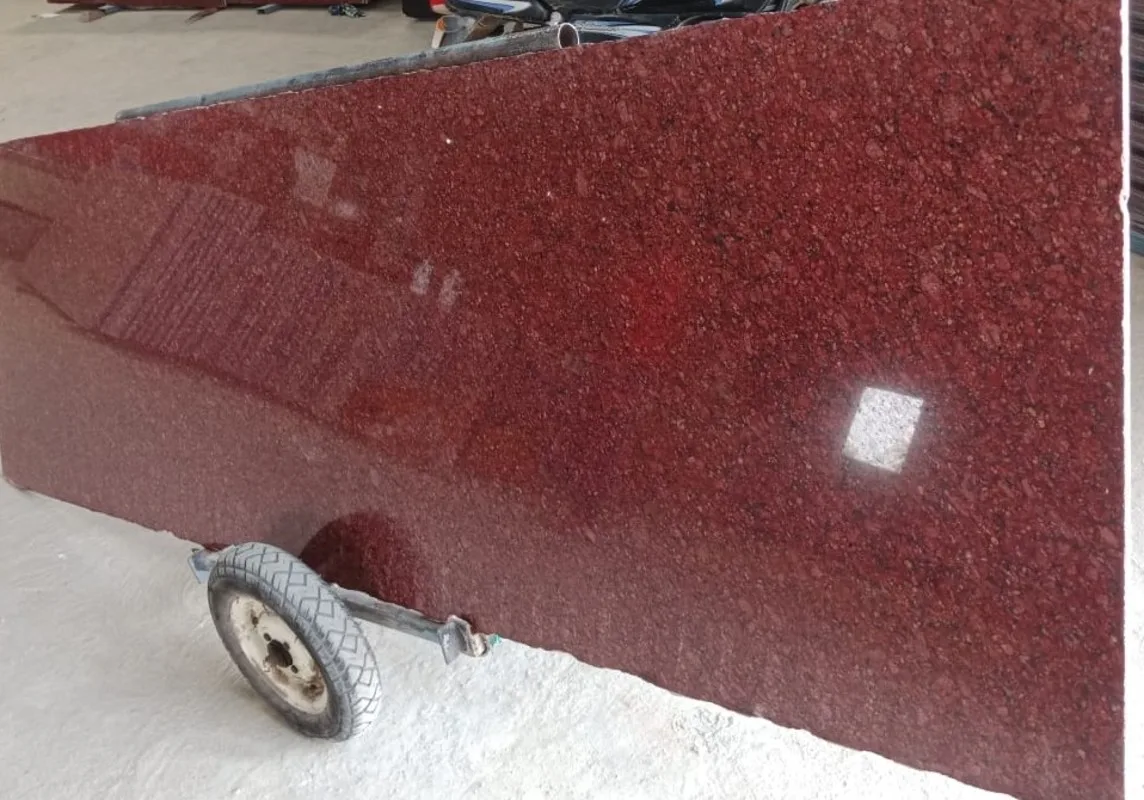

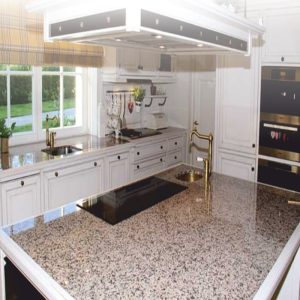
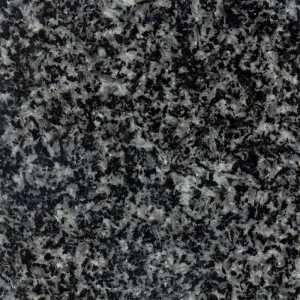

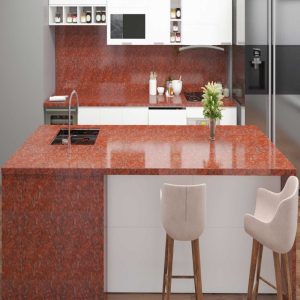
Reviews
There are no reviews yet.